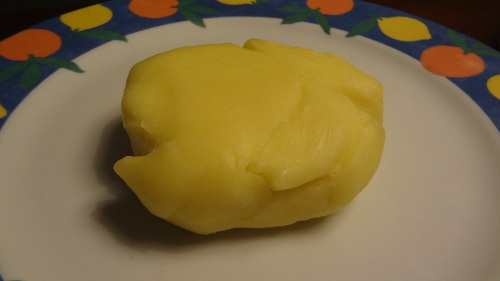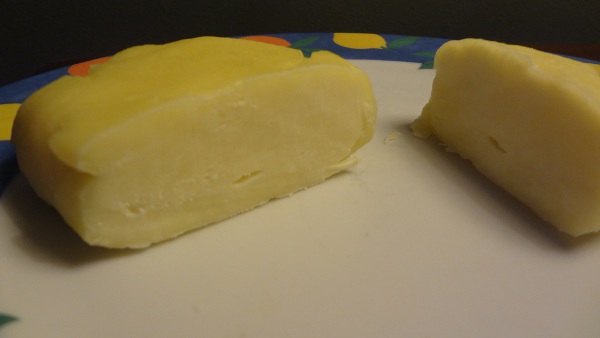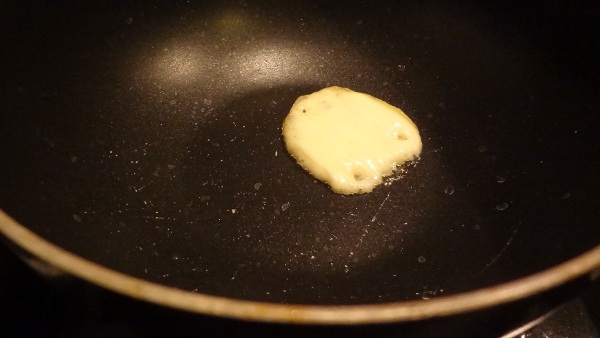The goal was mozzarella but some details decided otherwise.
I don’t know why, but so far I have not made mozzarella. Maybe it is because you can buy it for extremely little money and I don’t think it is a very special cheese. As a matter of fact; the cheap mozzarella’s have no taste at all. It seems like a complete waste of good milk.
Secondly, it requires gloves to protect your hands from the high temperature. Since my house is filled with all kinds of stuff for making cheese, wine and beer I could not be bothered with buying more.
But because I like to try to make all kind of cheeses I could not skip mozzarella because the way it is made is completely different from all other cheeses I tried before.
Ok. I’ll burn my hands a little.
Here is the recipe that I used in my own words:
Ingredients
- Citric acid 1 ½ tsp
- Milk 6L
- Calcium chloride 1,25 mL
- Rennet 1,25 mL
- Salt 90 mL (Yes. That is what the recipe says. I used 90 gm.)
- Bowl of ice water
Procedure
- Clean equipment.
- Dissolve Citric acid in a little water
- Mix Citric acid in the milk
- Warm milk slowly to 31 C
- Mix calcium chloride with a little water and add to milk
- Mix rennet with a little water and add to milk
- After 30 minutes, check for a clean break. If no clean break, wait for 15 minutes more.
- Cut curds in 1,25 cm cubes and wait for 5 minutes.
- Heat the curds slowly to 41 C. This should take 20 minutes.
- Stir for 20 minutes more and then leave it for 5 minutes
- In the same time boil 4 L water and dissolve the salt in it.
- Remove the whey from the curds and let it drain in cheese cloth for 15 minutes
- Place the curds on a cutting board and cut it in 2,5 cm strips.
- Place the strips in a large bowl and pour the hot salt water on it.
- Wear heat resistant gloves and stretch the strips into long ropes. The cheese becomes soft in the hot water. To test if it is ready for stretching you can try it with a small piece of cheese. If it does not stretch or breaks you should wait some more.
- When the cheese is smooth and shiny you make it into a ball or make several small cheeses.
- Place the cheese(s) in a bowl of ice water for 5 minutes.
- Eat immediately or wrap and refrigerate.
Ok. That is the way you should do it. But I ended up with absolutely no mozzarella. It was actually much better than any mozzarella I ever ate.
It ended up with the texture of a rubber ball. The colour was more yellow than white. The rind was firm like plastic but very thin and tasty. (Perhaps the cheese can even be kept for a few weeks.)
The taste was a bit sweet, a little nutty, milky and fresh. Very well balanced.
I tried to warm it to see if it can be used on a pizza and it melted very nicely.
Well, I did not make mozzarella. Now the question is of course; What happened?
There are some things that I did not do according to the recipe:
- When I started I noticed that I did not have enough citric acid. (Unbelieveable that I could run out of that.) So I used 2 tsp tartaric acid which is a little weaker than citric acid. I don’t think that it matters when you use it in 6 L milk. But who knows? Small details can make big differences.
- Since I use fresh milk I do not use calcium chloride.
These are the changes that I was aware of but I don’t think that they make a lot of difference.
I think that the greatest influence was the stretching.
I divided the curds in 3 pieces and when I wanted to stretch them they would only stretch for about 20 cm and then they broke. I waited for a while but it did not change a lot.
I decided to heat the curds some more and then they would stretch a lot better. Even better than chewing gum.
I believe that I tried to stretch them too much or often and that is why it became rubbery. But next time I am doing that again because the cheese was fantastic!
Hans
P.S.
In the mean time I have learned what I did wrong. If you want to make a proper mozzarella look here.




